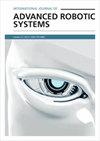A review on structural development and recognition–localization methods for end-effector of fruit–vegetable picking robots
IF 2.1
4区 计算机科学
Q2 Computer Science
International Journal of Advanced Robotic Systems
Pub Date : 2022-05-01
DOI:10.1177/17298806221104906
引用次数: 9
Abstract
The excellent performance of fruit and vegetable picking robots is usually contributed by the reasonable structure of end-effector and recognition–localization methods with high accuracy. As a result, efforts are focused on two aspects, and diverse structures of end-effector, target recognition methods as well as their combinations are yielded continuously. A good understanding for the working principle, advantages, limitations, and the adaptability in respective fields is helpful to design picking robots. Therefore, depending on different grasping ways, separating methods, structures, materials, and driving modes, main characteristics existing in traditional schemes will be depicted firstly. According to technical routes, advantages, potential applications, and challenges, underactuated manipulators and soft manipulators representing future development are then summarized systematically. Secondly, partial recognition and localization methods are also demonstrated. Specifically, current recognition manners adopting the single-feature, multi-feature fusion and deep learning are explained in view of their advantages, limitations, and successful instances. In the field of 3D localization, active vision based on the structured light, laser scanning, time of flight, and radar is reflected through the respective applications. Also, another 3D localization method called passive vision is also evaluated by advantages, limitations, the degree of automation, reconstruction effects, and the application scenario, such as monocular vision, binocular vision, and multiocular vision. Finally portrayed from structural development, recognition, and localization methods, it is possible to develop future end-effectors for fruit and vegetable picking robots with superior characteristics containing the less driving element, rigid–flexible–bionic coupling soft manipulators, simple control program, high efficiency, low damage, low cost, high versatility, and high recognition accuracy in all-season picking tasks.果蔬采摘机器人末端执行器结构发展及识别定位方法综述
果蔬采摘机器人的优异性能通常得益于末端执行器的合理结构和高精度的识别定位方法。因此,人们将注意力集中在两个方面,不断产生不同的末端效应器结构、目标识别方法及其组合。充分了解采摘机器人的工作原理、优点、局限性以及在各个领域的适应性,有助于设计采摘机器人。因此,根据不同的抓取方式、分离方法、结构、材料和驱动方式,首先描述传统方案中存在的主要特征。根据技术路线、优势、潜在应用和挑战,系统总结了代表未来发展的欠驱动机械手和软机械手。其次,还介绍了部分识别和定位方法。具体而言,针对目前采用单特征、多特征融合和深度学习的识别方式的优势、局限性和成功实例,对其进行了阐述。在3D定位领域,基于结构光、激光扫描、飞行时间和雷达的主动视觉通过各自的应用得到反映。此外,另一种称为被动视觉的3D定位方法也从优势、局限性、自动化程度、重建效果和应用场景(如单目视觉、双目视觉和多目视觉)进行了评估。最后,从结构开发、识别和定位方法来看,有可能开发出未来果蔬采摘机器人的末端执行器,该末端执行器具有驱动元件少、刚性-柔性-仿生耦合软机械手、控制程序简单、高效、低损伤、低成本、高通用性等优点,以及在全季节采摘任务中的高识别精度。
本文章由计算机程序翻译,如有差异,请以英文原文为准。
求助全文
约1分钟内获得全文
求助全文
来源期刊
CiteScore
6.50
自引率
0.00%
发文量
65
审稿时长
6 months
期刊介绍:
International Journal of Advanced Robotic Systems (IJARS) is a JCR ranked, peer-reviewed open access journal covering the full spectrum of robotics research. The journal is addressed to both practicing professionals and researchers in the field of robotics and its specialty areas. IJARS features fourteen topic areas each headed by a Topic Editor-in-Chief, integrating all aspects of research in robotics under the journal''s domain.

 求助内容:
求助内容: 应助结果提醒方式:
应助结果提醒方式:


